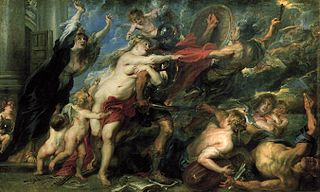 W
WConsequences of War, also known as Horror of war, was executed between 1638-1639 by Peter Paul Rubens in oil paint on canvas. It was painted for Ferdinando II de' Medici. Although commissioned by an Italian, art historians characterize both the work and the artist as Flemish Baroque. It serves as a commentary on a European continent ravaged by the Thirty Years' War, and the artist employed numerous symbols, both contemporary and ancient, to deplore the state of the continent.
 W
WLe Départ des poilus, août 1914 is a monumental mural by the American artist Albert Herter. The painting measures 12 by 5 metres and is displayed at the Gare de l'Est railway station in Paris, where it is suspended some 7 metres (23 ft) high on a wall in the Hall d'Alsace.
 W
WEndless Night is a painting executed in 1983 by Nabil Kanso in oil paint on canvas measuring 2.25 by 3 metres. It is part of a group of related paintings made by Kanso in response to the Lebanese Civil War. The painting depicts the ravages war in a scene that "embodies recurrent themes of carnage, suffering and the disintegration of humanity."
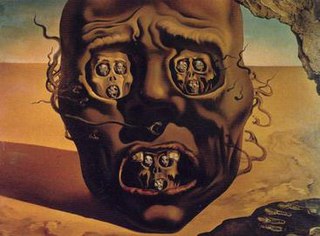 W
WThe Face of War (1940) is a painting by the Spanish surrealist Salvador Dalí. It was painted during a brief period when the artist lived in California.
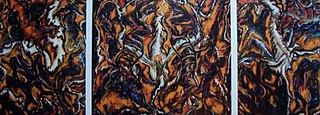 W
WThe Floating Shadows is a triptych made by Nabil Kanso in 1986 on the brutality and suffering inflicted during the Lebanese Civil War. The painting is oil on canvas and measures 2.75 x 7.60 meters. It forms part of the Cluster Paintings series that Kanso began in 1986 and marks the transition to a new approach in his compositional framework. The pictorial layout divides the canvas space into various sections reflecting a cluster of interlinked planes depicting floating figures of predominantly dark-blue set against deep orange ground and demarcated by white grayish areas.
 W
WGuernica is a large 1937 oil painting on canvas by Spanish artist Pablo Picasso. One of Picasso's best known works, Guernica is regarded by many art critics as one of the most moving and powerful anti-war paintings in history. It is exhibited in the Museo Reina Sofía in Madrid.
 W
WHiroshima Nagasaki One-Minute is the subject of two mural-scale paintings made by Nabil Kanso in 1978-79. One is titled 49-Second (Hiroshima) done in oil on canvas measuring 3 X 5.50 meters, the other 11-Seconds (Nagasaki) oil-on-canvas triptych measuring 3 X 4.60 meters center, and 2.75 X 1.32 meters each side.
 W
WLebanon is a mural size painting by Nabil Kanso depicting the Lebanese Civil War in a scene invoking the spirit and character of the people in the midst of horror and violence gripping the country. Amid the scene of chaos and devastation, two central figures reach across toward each other symbolically to represent the appeal for unity in defiance of the forces of division, destruction, and terror.
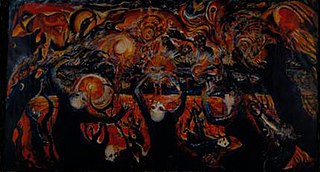 W
WLebanon Summer 1982 is the title and subject of a mural-scale painting made by Nabil Kanso in 1982 on the Sabra and Shatila massacre during the Lebanese Civil War. It is oil on canvas measuring 3 X 5.5 meters
 W
WLiving Memory is the title of a series of 9 mural-size paintings on the Holocaust painted by Nabil Kanso in 1980, 1990 and 1993-94.
 W
WThe Massacre at Chios is the second major oil painting by the French artist Eugène Delacroix. The work is more than four meters tall, and shows some of the horror of the wartime destruction visited on the Island of Chios in the Chios massacre. A frieze-like display of suffering characters, military might, ornate and colourful costumes, terror, disease and death is shown in front of a scene of widespread desolation.
 W
WMassacre in Korea is an expressionistic painting completed on January 18, 1951, by Pablo Picasso; it condemns American intervention in the Korean War. The painting is exhibited in the Musée Picasso in Paris.
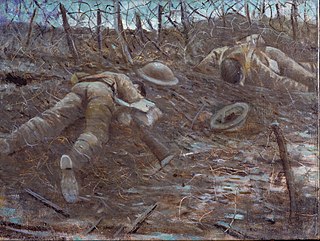 W
WPaths of Glory is a 1917 painting by British artist Christopher Nevinson. The title quotes from a line from Thomas Gray's 1750 poem Elegy Written in a Country Churchyard: "The paths of glory lead but to the grave". It is held by the Imperial War Museum in London, which describes it as "one of Nevinson's most famous paintings".
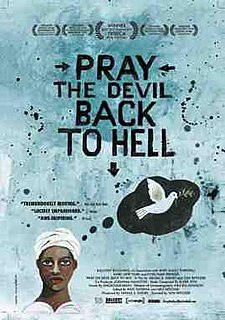 W
WPray the Devil Back to Hell is a documentary film directed by Gini Reticker and produced by Abigail Disney. The film premiered at the 2008 Tribeca Film Festival, where it won the award for Best Documentary. The film had its theatrical release in New York City on November 7, 2008.
 W
WThe remnants of an army, Jellalabad (sic), January 13, 1842, better known as Remnants of an Army, is an 1879 oil-on-canvas painting by Elizabeth Thompson, Lady Butler. It depicts William Brydon, assistant surgeon in the Bengal Army, arriving at the gates of Jalalabad in January 1842. The walls of Jalalabad loom over a desolate plain and riders from the garrison gallop from the gate to reach the solitary figure bringing the first word of the fate of the "Army of Afghanistan".
 W
WThe Split of Life is a series of over 80 mural size oil paintings by Nabil Kanso. The paintings span a period from 1974 to 1994, and deal with contemporary and historical issues of war and violence.
 W
WThe Third of May 1808 is a painting completed in 1814 by the Spanish painter Francisco Goya, now in the Museo del Prado, Madrid. In the work, Goya sought to commemorate Spanish resistance to Napoleon's armies during the occupation of 1808 in the Peninsular War. Along with its companion piece of the same size, The Second of May 1808, it was commissioned by the provisional government of Spain at Goya's suggestion.
 W
WThe Triumph of Death is an oil panel painting by Pieter Bruegel the Elder painted c. 1562. It has been in the Museo del Prado in Madrid since 1827.
 W
WVietnam is a mural-size painting made by Nabil Kanso in 1974 in response to the Vietnam War. It is done in oil on canvas measuring 3.65 by 7.30 meters.
 W
WThe Vortices of Wrath is a triptych painted by Nabil Kanso in 1977. It is part of the Lebanon series began in 1975 in response to the Lebanese Civil War. The triptych is done in oil on canvas measuring 3×7.60 meters. The center is 3×3 meters and each side 2.75×2.30 meters.
 W
WWar. The Exile and the Rock Limpet is an oil painting of 1842 by the English Romantic painter J. M. W. Turner (1775–1851). Intended to be a companion piece to Turner's Peace – Burial at Sea, War is a painting that depicts a moment from Napoleon Bonaparte's exile at Saint Helena. In December 1815, the former Emperor was taken by the British government to the Longwood House, despite its state of disrepair, to live in captivity; during his final years of isolation, Napoleon had fallen into despair. Turner's decision to pair the painting with Peace was heavily criticized when it was first exhibited but it is also seen as predecessor to his more famous piece Rain, Steam and Speed – The Great Western Railway (1844).